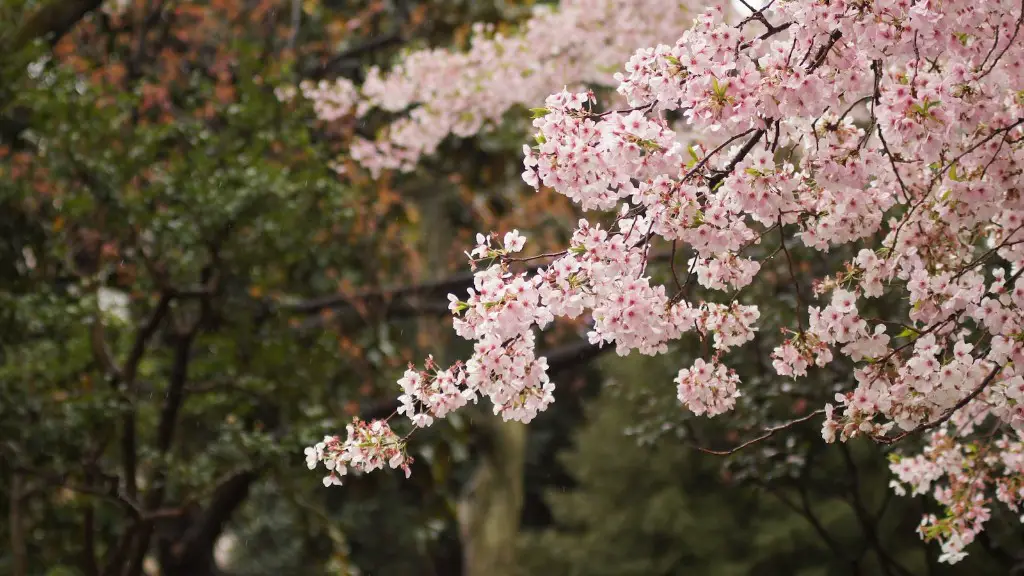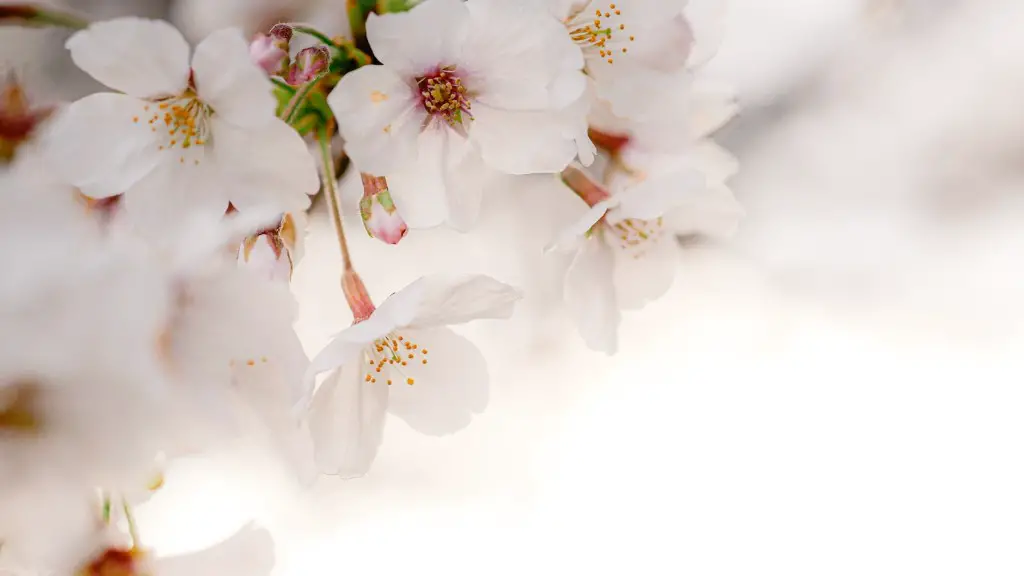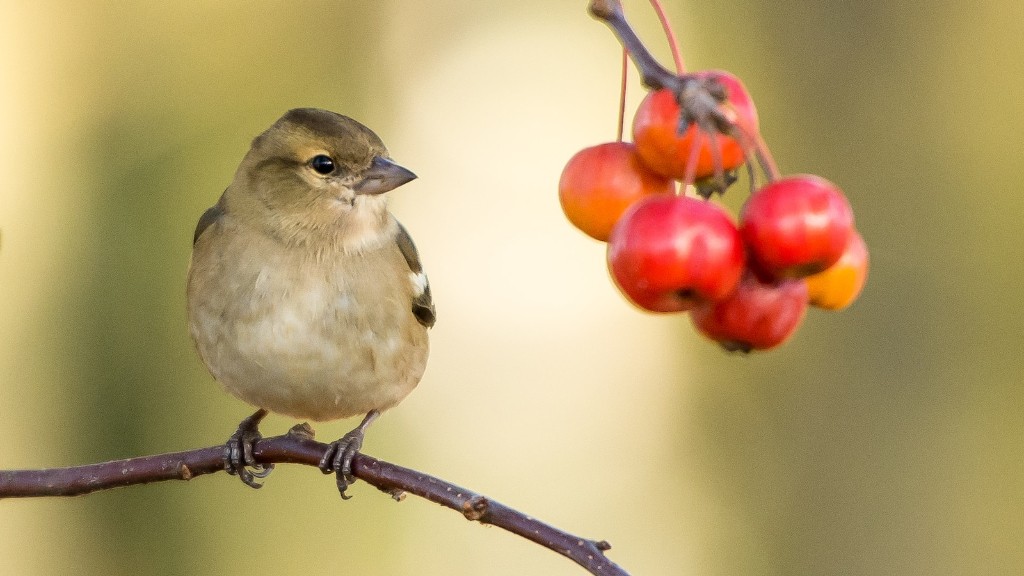Growing flowering cherry trees is a rewarding process and with the right care and maintenance, homeowners can enjoy a beautiful garden for several years. There are several varieties of flowering cherry trees that offer a range of colors, sizes and shapes. To help ensure a successful planting and reap the benefits of having a flowering cherry tree in the yard, it is important to follow a few simple steps to ensure a successful planting.
Before planting, it is important to determine the best location for a flowering cherry tree. The soil type should be considered, as well as the access to sunlight. Any soil that is deep, well-drained, and PH neutral is the right soil for a flowering cherry tree. The tree should be planted in the sunniest spot in the yard that gets some shade. The cherry tree should receive at least 6 to 8 hours of sun a day.
Another important step for planting a flowering cherry tree is to acquit the correct size of tree for the area. There are several species of flowering cherry trees, and each can have a different size, shape and reach. For example, the Orientaite flowering cherry tree can grow up to 25 feet tall, while the Yoshino flowering cherry tree can reaches heights up to 40 feet tall. Before planting, it is important to research the different species and decide which one will be the best fit for the area.
Once the size and location of the tree has been determined, it is time to pick out a flowering cherry tree from a nursery. When inspecting the tree, it is important to pay attention to the size and shape of the trunk. The trunk should be straight and not have any noticeable kinks. The tree should also have a healthy canopy of leaves, meaning that the leaves are green and vibrant. When purchasing the tree, make sure that the soil is loose and not compacted.
After the tree has been acquired, it is time to begin the planting process. Before planting, it is important to properly prepare the area. The area should be large enough to accommodate the tree’s roots, and the soil should be loosened and mound of dirt should be created in the center of the hole. Once the area has been prepared, the tree should be placed in the center of the hole and soil should be packed around the base of the tree. The tree should be secured by tying a rope around the trunk and the mound of soil.
Next, it is important to provide the tree with the proper amount of water. Water the whole tree until the soil is saturated. During the first 2 weeks of growing, the tree should be watered daily. Once the tree is established, it should be watered once a week. When the soil is dry and the temperature is hot, it may be necessary to water more often.
Lastly, it is important to fertilize the tree every spring and summer. When fertilizing the tree, it should be done with a slow-release fertilizer that is formulated for flowering cherry trees. Before adding fertilizer to the tree, it is important to read the package and make sure that the proper amounts are added. Too much fertilizer can damage the roots of the tree and cause it to become unhealthy.
Mulch
Securing the roots of a flowering cherry tree is essential for it to grow healthy and strong. Keeping the soil moist and ensuring that it does not dry out is an important step. To help retain moisture and keep the soil temperature consistent, adding mulch is recommended. The mulch should be placed at least 3 inches away from the trunk of the tree, as this will help prevent any damage from the mulch material.
When applying the mulch, make sure to spread out a layer of material in a circle around the tree. The layer should be 4 inches thick and should reach around 4 feet away from the trunk of the tree. This layer will help protect the roots and maintain moisture in the soil.
In addition to helping the tree retain moisture, mulch can also help the tree get the vital nutrients it needs to grow. Organic mulch is recommended as it will add additional nutrients such as nitrogen, phosphorus and other vital minerals to the soil. This helps ensure that the tree has access to the nutrients it needs as it grows.
Lastly, mulching a flowering cherry tree reduces the growth of weeds. By preventing the growth of weeds, the tree can get the nutrients it needs and decrease the risk of disease and pest infestations. It is important to replace the mulch layer on the tree every year to ensure that the tree is getting the necessary nutrients.
Pruning
Pruning is also an important step in taking care of a flowering cherry tree. While pruning, focus on removing any damaged or diseased branches to maintain the tree’s health. In addition, prune portions of the tree if it is preventing light from reaching other parts of the tree and keep the canopy at a safe height to avoid any injury or damage to the tree and nearby objects.
When pruning the tree, use clippers or a saw and make sure to sterilize them with a solution to reduce the risk of disease transfer. Additionally, always prune away branches that cross each other and those that are dead or diseased. The branch should be cut as close to the tree trunk as possible, but make sure not to damage the bark. It is important to take note of the shape, size, and location of each branch as this will help when cutting and forming a symmetrical tree.
After pruning is done, it is important to clean up the area. Remove all the branches, leaves, and debris from the area and dispose of properly. Before replanting any parts of the tree, it is important to sterilize the pruned area with a solution to help prevent the spread of any diseases.
Pests and Disease
Pests and diseases can take a toll on a flowering cherry tree. A few pests that frequently feed on cherry trees are aphids, mites, caterpillars and scale insects. To prevent pests and disease, there are several steps that can be taken proactively.
Before a pest or disease problem arises, examine the soil around the tree and make sure that it is not too wet or dry. In addition, inspect the branches, leaves and twigs for any signs of disease or pests. If a problem is identified, treat it promptly as this will help prevent it from spreading. If the problem is a pest infestation, pesticides can be used to eliminate them.
To protect against disease, selectively prune branches and twigs that appear to be infected and take the necessary steps to improve the tree’s overall health. Fertilizing the tree twice a year and monitoring the soil moisture will also help reduce the risk of disease and pests.
Fertilization
Fertilizing a flowering cherry tree can help it grow and thrive. Slow-release fertilizers are the best fertilizers to use as they slowly release the nutrients into the soil. When fertilizing, make sure to follow the directions on the package as too much fertilizer can cause damage to the tree’s roots.
Before fertilizing, it is important to test the soil pH levels. A neutral soil pH (7.0) or slightly acidic soil (6.0 – 6.8) is ideal for flowering cherry trees. If the soil is too acidic, it can prevent the tree from getting the nutrients it needs. To resolve this, it is recommended to use a soil amendment to raise the soil pH to the ideal level.
It is also important to be aware of any nutrient deficiencies in the soil. To determine if a nutrient deficiency exists, perform a soil test which will detect any missing nutrients. If the soil is deficient in a certain nutrient, adding fertilizer with that specific nutrient can help the tree gain the minerals it needs.
Tree Care
Overall, taking the necessary steps to care for a flowering cherry tree is essential for promoting a healthy and thriving tree. Regular maintenance such as pruning, mulching, and fertilizing will help ensure the tree’s longevity and robust health. With the right care, the tree can survive and flourish for many years.
When caring for a flowering cherry tree, it is important to pay attention to any signs of disease or pest infestations. If a problem is identified, take the necessary steps to treat it promptly. Protect the tree against extreme temperatures and make sure to prune the tree at least once a year. Lastly, monitoring the soil’s nutrient levels and providing the tree with the proper amount of water will help keep the tree healthy and strong.
When planting a flowering cherry tree, the most important step is to choose the correct variety for the area. Additionally, be sure to select a tree that is healthy, sturdy, and vibrant. It is also important to prepare the area before planting and make sure that the soil is proper and not too dry. Water the tree thoroughly, mulch the area and fertilize it frequently. Prune the tree on a regular basis and take necessary steps to disclose and address any signs of disease or pest infestations.




